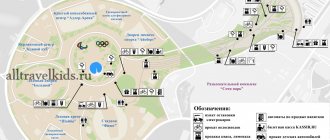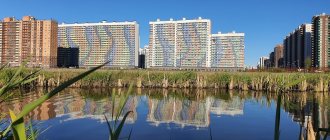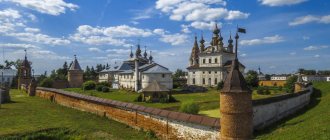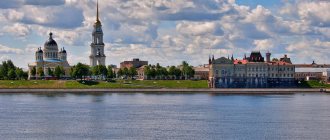All districts in the Saratov region with a map are here: Districts of the Saratov region The official website of the city of Atkarsk is here. In Russia there are many large and small cities that are located apart from popular tourist routes, and therefore are undeservedly forgotten. But it is precisely such cities that, as a rule, are of particular interest. And they are also worth visiting to be periodically reminded of how beautiful our country is and how much interesting things there are in it.
Atkarsk is located in the Saratov region, in the Volga Upland zone, where the two rivers Atkara and Medveditsa unite; it is located 92 kilometers from the center of the region. The area of the immediate settlement is 10.5 kilometers. The city was founded at the end of the eighteenth century, and for a long time was afloat thanks to the grain trade.
In the next century, a fire destroyed most of the city. The city was rather unsettled and gray before the fire, but now it has acquired a special homeliness. They began to call it Straw Town.
How to get there?
To get to this town you can take the Moscow-Saratov train, which stops right in Atkarsk. Other trains of different directions also pass here, for example to Almaty or Astrakhan.
General information and historical facts
The area is part of the historical Great Steppe. For a long time, this area was inhabited by nomadic peoples. Sarmatians, Khazars, and Polovtsians once lived here. In 1358, on the site of today's city there was an ulus of the Tatar Khan Etkara. In 1699, thanks to the order of Peter 1, a settlement was formed in this area, which was subordinate to the Petrovsky governor.
Almost 90 years later, when Catherine II was in power, the settlement turned into a county town with the name Atkarsk. By the beginning of the 19th century, the number of inhabitants was 1,200 people. In 1870 there was a big fire, during which most of all the buildings of the city disappeared. Two years later, the Tambov-Saratov railway line was put into operation, which in the future had a great influence on the rapid prosperity of the city.
By 1907, the population was already more than 13 thousand people. At the beginning of the 20th century, the settlement could already boast of a couple of steam engines, a couple of mills, and a locomotive depot. There were four brick factories, one soap factory, a couple of grain mills and several other enterprises located here. In 1928, Atkarsk was declared the center of the Atkarsky district of the Saratov region, in the Lower Volga region.
In the 1960s, multi-storey buildings appeared in the area, in the form of residential buildings and kindergartens. A clinic, a cinema and other social and administrative buildings began to function.
The modern city has a machine-building plant and a couple of metalworking factories, a furniture factory, a couple of clothing factories, and several processing organizations.
To make calls to the city you will need to dial the area code “84552”. And to send letters, you should remember the postal code “412420”.
Attractions and entertainment
After the fire, the city was actively developed: stone and brick buildings appeared. And since the peak of the city’s heyday as a commercial city began along with active construction, the result turned out to be excellent. Visitors immediately note that the railway station building itself has cheerful colors and elements in the neoclassical style. After this, I want to examine in detail the architectural features of the city. Let's get to know what interesting things there are in the city and why it is attractive. The House of Culture is a monument of constructivism. The city administration is externally designed in a rare neo-Russian style, which was very fashionable at the beginning of the 20th century. Women's gymnasium - formerly it was an executive committee, then a school with a technical school. During the war, a military hospital was located here, and then captured Germans were brought here. Now it houses a boarding school.
The city has many buildings made of neatly laid red bricks. There are buildings with towers, projections, balconies, and architraves. They are in fair condition and are not subject to modern restoration. The historical center has many such buildings that create the appearance of comfort, creating the impression of a good prosperous city, as it was many years ago. There are almost no tall buildings here, which makes it possible to fully perceive all the monuments in the right atmosphere. The zoo, which is already more than fourteen years old, is the real pride of the city. There are not many animals here, but they are all of interest to both locals and tourists. There are wolves, and deer, and bears, and wild boars. Among the small pets there are rabbits and nutria. Entertainment in the form of attractions has been built for children.
Arboretum and nursery of ornamental crops. Those who love nature, and especially lilacs, should definitely visit this place. After all, a unique collection of lilacs and its different types is presented here. The formation of an arboretum has become an urgent need, since greenery in this area is needed to stop soil erosion. There are also exotic plants here. Their research focuses on local adaptation. The trees that grew here were once planted near the Moscow Kremlin.
Marfinskaya park area is an oasis of coniferous forest near the steppe zone. The peculiarity of the park is that it contains trees that are not accustomed to this climate, for example, larch, fir and spruce. Like any decent park, it has its own radial planning system. To create such a unique composition, great effort and expense had to be made, since during drought there is artificial watering through irrigation channels.
The BMP.1 combat vehicle is a memorial opened nearby seven years ago. Cinema - the first building was erected by chief machinist Kapustin back in 1904. The fairytale carriage is an art object that looks like a sculpture of a unicorn and a carriage, installed in Atkarsk a year and a half ago. A local history museum that is worth visiting for anyone who is not yet familiar with the history of the city, this area and knows nothing about the development of industry here. Central Park - it is constantly maintained. It contains a monument to the famous commander Rokossovsky, as well as Marshal Zhukov. A bust of J.V. Stalin was erected on one of the alleys.
In the center there are many buildings built at the end of the 19th century. They are architectural monuments, unique and interesting objects from a historical point of view.
In the center there is an old building in which noble meetings were held for a long time. There was a library in the school building at that time.
Atkarsk. Party bigwigs in the park and the street of red brick schools
The district ]Atkarsk[/anchor] outside the Saratov region is known to fans of pop music as the birthplace of the singer Valeria. The pop diva, as they say, does not come here often in recent years. In the region, Atkarsk is also known as a large railway station, where trains from and to Saratov stop, and the birthplace of the “Atkar rose” (this variety, and even a festival is held in honor of the flower).
Atkarsk received city status in 1780 by decree of Empress Catherine II. Now it is home to just over 25 thousand people. The small town doesn’t have a lot of attractions, but we, of course, found something.
If you arrive in the city by car, then at the fork you will be met by archers with a cannon (a statue, of course). On the banks of the Medveditsa River in the town of Etkara (now Atkarsk) a settlement was founded in 1699. Its first inhabitants were soldiers who served to protect the lands from raids, mainly by nomads. The soldiers guarded and at the same time earned their own food - they were engaged in arable farming. In those days, the settlement was subordinate to the governor, who lived in Petrovsk. Not much is known about the history of the city, but we have compiled a walking route for you, covering as many of the local attractions as possible.
We usually go to Atkarsk by train (trains also stop here, but not for long). We are greeted by the railway station building, built in 1894. The monument of urban planning and architecture of regional significance was renovated not long ago. On the platform there is a chapel and food stalls.
Ilyich meets us on the station square, pointing his hand somewhere into the bright distance. It was made by the sculptor G.D. Alekseev, and when is unknown.
We go out onto Chapaeva Street, turn right and walk to the intersection with Vali Makeeva Street. At its beginning there is a bust of a pioneer woman from Atkarsk, killed by her stepfather in Soviet times. Nearby is the Peter and Paul Church, built with money from benefactors Robert and Natalia Crattli. The first service was held within its walls on December 15, 2013. The last interesting building on this street for us is the former women's gymnasium, built in 1905-1907. Over the years there was a district executive committee, a school, a hospital and housing for Nazi prisoners of war. Now it is empty, and the extensions are occupied by a cafe and a hotel.
From Chapaev down Sovetskaya Street we will pass several red brick buildings. House No. 92 is a former vocational school, and then a school where the future actor, Atkar resident Boris Andreev, studied. At the intersection you can see a building typical of county towns - a fire tower from the beginning of the last century.
And again on our way there is a red brick building - but with green domes. This is another school (No. 9), which before the revolution was the Women's Primary School. The abundance of educational institutions in this microdistrict is reflected in the monument to the First Teacher erected in the public garden. The teacher hugs the student and holds a book against the background of the ABC book.
We pass further and see the Church of the Archangel Michael. Until 1933, there was a cathedral of the same name on this site, built in the 19th century. In the 1990s, the Orthodox were given the courthouse, which was extensively renovated and turned into a temple.
To have a complete picture of the red brick Atkarsk, you need to walk one block down. House No. 66, built at the turn of the 19th and 20th centuries, houses the Children's Creativity Center. The next building (house no. 64) dates back to the same era as its neighbor. It was built for the District Assembly, and now the administration of the Atkar district is stationed here.
Let's turn right onto Gagarin Street and walk to houses No. 48 and 50. This is the former property of the merchant Bozhedomov - a residential building and a storage shed. Timofey Lukyanovich Bozhedomov built a steam mill in Atkarsk at the end of the 19th century and opened two shops. In the courtyard of his estate there were outbuildings and warehouses.
It's time for us to return to the intersection with Sovetskaya Street and go to its odd side. Here, in house No. 91, at the beginning of the twentieth century lived the mayor (simply the mayor) Fyodor Nikolaevich Pavlyukov. Another reminder of him is a boulder with a memorial plaque in front of house No. 93 on Sovetskaya Street.
The bust of Alexander Pushkin is located in the next block up Sovetskaya. And the neighboring building is perhaps the most atypical for Atkarsk. Construction of the Constructivist State Bank began in 1931, but no one knows when it was finished. Money was stored in the basement, and depositors were served on the second floor. Now there is a Social Security Center, shops, a hairdresser and all sorts of other things. And the “green area” across the road—the Park Museum—is calling us.
As we have already said, a rose festival is taking place in modern Atkarsk. During the Soviet years, there was a nursery in the city where they grew flowers and supplied them not only to their region: Atkar roses decorated many cities of the Soviet Union. Now roses are not grown in the nursery, there are plans to restore this business, but the revival began with the festival. It is held on the territory of the Park Museum, and here it is, perhaps, the most important attraction of the town. Monuments, a local history museum and a zoo are “housed” in a small area.
The park museum is located in the historical part of the city. The local history museum is located in a one-story building from the early 20th century. It once belonged to the local Orthodox parish; it was built next to the church, which was demolished during the Soviet years. “Love your land,” says the inscription above the museum windows.
Several halls display archaeological finds, household items, and documents. Separate exhibitions are dedicated to famous Atkar residents - People's Artist of the USSR Boris Andreev, writer Mikhail Alekseev, and, of course, the aforementioned singer. A careful study of the exhibition is unlikely to take more than an hour.
A walk through the park, in good weather, will be a great pleasure, because interesting sculptures are exhibited there. Atkarchans collected a variety of statues - fairy-tale characters, military leaders, politicians. In 1967, a sculpture was installed in the park in memory of those killed during the Civil War, which is called “Fighters of the 1917 Revolution.” On the gray wall is a bas-relief depicting a commissar, a soldier and a sailor. Once upon a time this monument had an Eternal Flame.
The extraordinary Memorial of Glory was erected in memory of the city residents who died in the Great Patriotic War. The Eternal Flame burns in front of him. Busts of Marshals Zhukov and Rokossovsky are installed nearby.
The park’s “collection” includes busts of Karl Marx, Vladimir Lenin (by the way, next to the park there is also a monument to the leader of the proletarian revolution), Joseph Stalin. The sculptures of a pioneer woman with a flag and a bugler date back to the Soviet era. By the way, there are exactly the same ones in the lobby of school No. 3.
Atkar residents paid tribute to the memory of the mayor Fyodor Pavlyukov. “From grateful descendants - to a man who dedicated his life to the development of the city of Atkarsk,” is written on the pedestal. The monument was erected quite recently - in 2014.
In the park there is a bust of the writer Arkady Gaidar, the “all-Union elder” Mikhail Kalinin (he visited Atkarsk), the first cosmonaut Yuri Gagarin (he took to the skies in Saratov and returned to Earth from space in the Engels region).
On one of the alleys, visitors are greeted by a pair of lying lions. In the park, an eagle spread its wings on a small pedestal. Anyone can try to put their head into the mouth of the crocodile sculpture. There is also a fairy-tale king, and characters from Pushkin’s fairy tales - a scientist cat on a chain and the head of Chernomor.
There is also a mini-zoo adjacent to the park-museum. There are not very many animals there - wolf, fox, deer. Its main resident is the bear Savely, who has lived here since the opening of the living area. They say that it was given to the Atkar Zoo in 1999 by the then governor Dmitry Ayatskov.
And we finish our walk around Atkarsk, leaving the park-museum from the side of two fountains. Here is the Boris Andreev Leisure and Cinema Center, the former Rodina cinema. It was built in 1959, and the interior retains many of the decorative details of that time.
Transport and trade
Atkarsk has a modern railway station that connects this place to Tatishchevo, Saratov, Ekaterinovka. The city has public transport in the form of buses and minibuses. From the city bus station there are constantly buses to Saratov, Rtishchevo, Ekaterinovka.
As already mentioned, the trade in bread, the main “gold” of the region, in distant years turned the Saratov province into one of the main centers of the Russian economy. A key role in the development of the city was played by its location between the main centers of grain trade, Saratov and Balashov. But the city has always stood apart from its neighbors, which were stronger in all respects.
At one time, the key event was the opening of a station in the Tambov-Saratov direction, as well as the creation of a branch to Volsk. Since that time, there has been an influx of specialists in various fields, from workers to artisans. With the advent of roads, the economic and geographical position has improved, the city has become a major point of grain trade.
All villages brought grain to the city, where merchants purchased it, and then sent it by train to the capital and other large cities. Every year, up to three million pounds of bread were brought here. Nowadays, the city is popular for the production of equipment for the mining and processing industry, as well as, as before, for the supply of agricultural products.
History paragraph
Atkarsk is surrounded by two rivers - Atkara and Medveditsa. The city was founded at the end of the 18th century and existed through the grain trade. In the 19th century, fire destroyed two-thirds of the city, which was so shabby and unsettled that it was called Straw Town.
Of course, this is already in the distant past. The opening of the Tambov-Saratov railway stirred up this sleepy town, and by the beginning of the revolution, workers, merchants, and artisans lived here. The importance of Atkarsk as a center of grain trade gradually increased. The revolution opened up new horizons for the city, including in industry. Until now, one of the main activities of the city is the production of equipment for the mining industry.
The Atkar Arboretum was founded before the revolution and is rightfully famous not only in the Saratov region, but throughout Russia.








